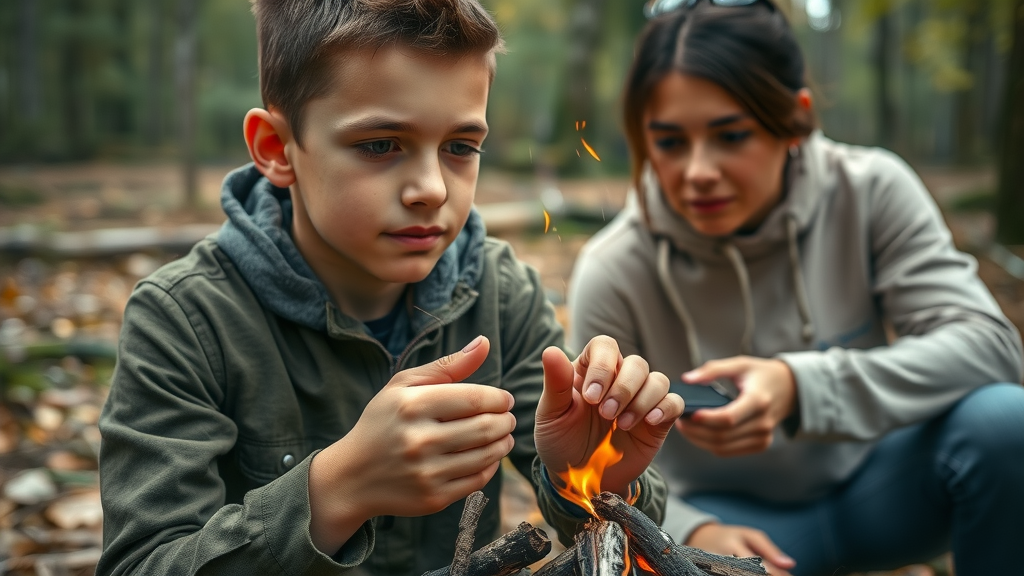Did you know? Recent studies indicate that wilderness therapy programs can double the likelihood of lasting mental health improvement for young people when compared to traditional therapy approaches. As rates of anxiety and depression remain high among young adults, families and professionals are turning to nature-based healing. But do these wilderness therapy techniques really work, and what exactly do they involve? In this comprehensive guide, discover the unique blend of adventure, therapy, and experiential learning that is changing lives and restoring hope—one expedition at a time.

Wilderness Therapy Techniques: The Transformative Impact Backed by Surprising Statistics
- You'll discover the latest wilderness therapy techniques , how adventure therapy and experiential therapy work together, and why these approaches are recommended for young adults seeking healing.
“Recent research shows that wilderness therapy programs achieve a 60% success rate in sustained mental health improvement for young people compared to 30% in traditional settings.”
Wilderness therapy techniques are having a profound effect on the lives of young adults , far surpassing many conventional approaches. These cutting-edge therapy programs blend outdoor activities with therapeutic interventions, creating a unique form of therapy that harnesses the healing power of immersion in a wilderness setting . With outcomes boasting higher success rates in combating mental health challenges such as anxiety, depression, and substance abuse, it’s little wonder families are investing in these nature-based solutions. By spending time in the great outdoors, participants are challenged both physically and emotionally—building resilience, confidence, and lasting behavioral change.
The success of wilderness therapy programs lies in their powerful combination of adventure therapy , group dynamics, and experiential therapy . Participants engage in activities that require teamwork, problem-solving skills, and self-reflection, resulting in improved emotional regulation and social skills. This article will guide you through the core principles, practices, phases, and real-world benefits of wilderness therapy, empowering you with the knowledge to make informed decisions for yourself or a loved one.
Understanding Wilderness Therapy Techniques and Their Core Principles
Wilderness therapy techniques integrate the best practices from psychology, education, and adventure activities to foster personal growth in a natural setting . Unlike traditional therapy programs that typically occur in an office or group room, wilderness therapy takes therapy to the forest, mountains, and rivers—spaces proven to have a positive effect on mental health. The guiding principle behind these techniques is that spending time immersed in nature, combined with evidence-based therapeutic support, can accelerate and deepen the healing process for young people .
At the heart of wilderness therapy programs is the goal of providing a safe space for self-discovery, supported by skilled staff who use both adventure and therapy modalities. Experiential education, mindfulness exercises, and purposeful challenges are core to this process, encouraging participants to break through barriers and achieve personal growth. By integrating therapy and adventure , these programs appeal to a diverse group—including those who have struggled to find success in conventional therapy settings.
What Sets Wilderness Therapy Techniques Apart From Traditional Therapy Programs?

Unlike traditional therapy, where the treatment approach relies on structured conversations and counseling sessions indoors, wilderness therapy techniques thrive on outdoor experiences . These programs combine individual and group therapy in the wilderness with adventure activities such as hiking, survival skills, and team-building challenges. The natural environment acts as both a catalyst for change and a metaphorical classroom, giving participants the opportunity to experience breakthroughs outside their comfort zone.
While both approaches offer a safe space and professional guidance, wilderness therapy and adventure therapy programs yield a more powerful, experiential impact. Physical challenges like rock climbing or solo reflection exercises support emotional breakthroughs by pushing young adults beyond their perceived limits. As they master survival skills and complete challenging hikes, participants gain confidence, independence, and a greater sense of control over their lives—results often harder to achieve in a traditional setting.
The Fusion of Adventure Therapy and Wilderness Therapy for Young Adults
Adventure therapy and wilderness therapy are often used interchangeably but have distinct roles within these healing environments. Adventure therapy leverages action-based experiences like obstacle courses and group problem-solving, strategically integrated into a broader wilderness therapy program . For young adults who may struggle in talk therapy, these approaches provide concrete opportunities to apply new skills, face fears, and practice healthier communication.
By fusing the immersive aspects of wilderness therapy (canoe trips, camping, bushcraft) with therapeutic interventions from adventure therapy (group challenges, staged conflict resolution), young people are exposed to real-life scenarios that translate directly to everyday life. The synergy between adventure and formal counseling sessions makes the process more engaging and relevant, resulting in more profound, sustainable changes.
| Approach | Setting | Activities | Outcomes | Target Group |
|---|---|---|---|---|
| Wilderness Therapy Techniques | Outdoor, remote, natural settings | Hiking, survival skills, group challenges, mindfulness | Increased resilience, self-esteem, better mental health | Young adults, teens, at-risk youth |
| Conventional Therapy Programs | Indoor, office or clinic | Talk therapy, psychoeducation, group therapy | Emotional awareness, coping strategies | All ages, broad mental health needs |
Real-Life Applications: What Do You Do in Wilderness Therapy?
One of the most common questions from parents and young adults considering wilderness therapy is, “What do you actually do in these programs?” Unlike therapy sessions in traditional environments, wilderness therapy techniques are designed to immerse participants in hands-on activities that teach responsibility, foster teamwork, and encourage self-reflection.
During these programs, young people learn real survival skills, navigate group dynamics, and confront personal challenges in a natural setting . These experiences, from backpacking expeditions to communication workshops by the campfire, create the foundation for meaningful growth. The structure of each daily routine is carefully orchestrated to balance physical challenge, emotional support, and rest, ensuring every participant gets the most from their time involved in wilderness therapy.
Typical Activities in Wilderness Therapy Programs
- Hiking expeditions across scenic trails
- Team-building challenges and group problem-solving
- Learning primitive survival skills such as fire-making and shelter-building
- Solo reflection exercises and journaling
Wilderness therapy programs intentionally challenge participants with novel outdoor activities—many experiencing these for the very first time. From team-led hikes and group cooking to navigating orienteering courses, these sessions teach resilience and the value of interdependence. Solo reflection periods offer quiet time for self-assessment and journaling, while group discussions foster community and shared growth. By rotating between activity and reflection, participants gain deeper insights into their strengths, triggers, and thresholds.
Experiential Therapy Techniques in Practice

Experiential therapy plays a pivotal role in wilderness therapy techniques , moving beyond simply talking about problems to actively working through them. Activities like guided fire-building and shelter construction become metaphors for coping with internal challenges. With a therapist's guidance, young adults practice problem-solving skills under real-world conditions, developing the self-efficacy needed for lifelong change.
This treatment approach leverages the unique power of “doing” as a catalyst for growth and insight. Through direct outdoor experiences, participants internalize new skills for self-regulation and emotional control. These positive effects are amplified by frequent group debriefings, where each young person reflects on their learning and commits to applying new skills after leaving the wilderness therapy program .
"Outdoor challenges foster self-discovery and resilience by pushing young adults beyond their perceived limits."
Adventure Therapy: Blending Wilderness Therapy and Therapy and Adventure Techniques
Adventure therapy is more than an adrenaline rush—it’s an intentional, structured feature within many wilderness therapy programs . By combining action-oriented outdoor activities with therapeutic principles, adventure therapy bridges the gap between physical challenge and emotional growth for young people. The skills, insights, and confidence built through these experiences translate directly into everyday challenges at home, school, and in relationships.
This hybrid form of therapy and adventure engages both the body and mind. Participants must cooperate, trust peers, and push through discomfort, all under the watchful eye of a trained therapist. The organic nature of adventure activities often flushes out real behavior patterns and emotional triggers, providing rich material for therapy discussions and personal reflection.
Adventure Therapy in Wilderness Therapy Programs

Adventure therapy elements such as ropes courses, rock climbing, and water-based challenges are carefully integrated into wilderness therapy and adventure programs. These activities require trust and collaboration, making them ideal for building communication and resolving conflicts among young adults . Tasks like crossing a high ropes bridge or navigating a challenging trail together reveal each participant’s strengths and provide ample practice in healthy risk-taking.
These action-packed moments aren’t purely recreational—they serve as live case studies, enabling therapists to observe behavior patterns up-close. The group’s shared challenges mimic real-life stressors but within a supportive, low-stakes environment, offering controlled opportunities for personal triumphs and group success.
Key Benefits of Adventure Therapy for Young People
- Builds confidence and self-reliance through overcoming fears
- Develops advanced problem-solving skills in real-time
- Reinforces healthy social connections and teamwork
Young people benefit immensely from adventure therapy, especially those involved in wilderness therapy who may have experienced past trauma or struggled with substance abuse. Successfully crossing an obstacle course or leading a team challenge can rewire self-perception, instilling a sense of competence and hope. Over time, these therapy programs nurture skills directly transferable to personal, academic, and professional life—building a foundation for long-term success.
Wilderness Therapy for Mental Health: How Nature Heals
The healing power of nature is a cornerstone of wilderness therapy techniques . Increasing research shows that regular spending time in a wilderness setting lowers stress hormones, boosts mood, and fosters emotional stability in young adults . Unlike other forms of therapy, outdoor programs immerse participants for days or weeks, maximizing the mental health benefits of outdoor activities .
For many who have not found relief from talk therapy or medication alone, the structured use of nature-based therapy offers new hope. The unique combination of physical exertion, connection with the natural world, and purposeful therapeutic intervention creates an ideal ecosystem for healing and transformation.
Addressing Anxiety, Depression, and Trauma with Wilderness Therapy Techniques

wilderness therapy is particularly impactful for young people struggling with anxiety, depression, trauma, or substance abuse. Therapeutic outdoor experiences such as mindful hiking, riverside meditation, or nature journaling offer powerful coping strategies in the here and now. The safe, supportive environment of wilderness therapy programs , guided by experienced clinicians, enables participants to confront their pain, build resilience, and rediscover a sense of purpose.
Through group and individual therapy sessions, time spent in a natural setting helps recalibrate the nervous system, reduce symptoms, and restore hope. Participants develop new routines, learn healthier habits, and are often able to address root causes in a holistic way that traditional therapy programs sometimes miss.
Long-Term Impacts on Mental Health for Young Adults
The benefits of wilderness therapy for mental health endure long after the program ends. Numerous studies have documented sustained improvement in mood, self-worth, and relationships for young adults who participated in these programs. The lessons and coping skills learned in the wilderness empower young people to handle stress and setbacks in healthier ways, reducing the likelihood of relapse into old behaviors.
Families and clinicians often report that the positive effects—such as decreased anxiety and depression, better communication, and increased self-sufficiency—are among the most sustainable gains witnessed through any therapy program . When properly structured and supported, wilderness therapy acts as a launchpad for lifelong well-being.
Wilderness Therapy Programs: Structure and The Phases of Healing
Every wilderness therapy program is designed in phases that mirror the journey of personal transformation. Understanding these stages can help families set realistic expectations and support their loved ones before, during, and after the experience. Each phase plays a vital role in moving young adults from initial resistance to active engagement, and finally, to meaningful, lasting change.
Program structure typically begins with careful assessment and orientation, followed by deep immersion in the wilderness setting . Growth accelerates through physical, emotional, and social challenges, culminating in a plan for integration and aftercare back home. This phased approach is key to why wilderness therapy techniques offer such a powerful treatment approach for persistent mental health and behavioral challenges.
What Are the Phases of Wilderness Therapy?
- Preparation & Orientation: Assessment, introduction to program, setting intentions
- Immersion & Engagement: Active participation in wilderness and group activities, facing challenges, emotional processing
- Growth & Transformation: Mastering new skills, internalizing lessons, achieving therapeutic breakthroughs
- Integration & Aftercare: Planning for return home, connecting with ongoing support, maintaining gains

The transformation that occurs during a wilderness therapy program is visible at every stage. Initially, participants may feel apprehensive or withdrawn, but as the days progress, teamwork and self-reliance blossom. By focusing each phase on specific goals, young adults experience profound changes that can be reinforced and sustained in daily life, long after they exit the program.
Professional aftercare and family involvement are critical to maintaining the momentum developed in the field. Many programs offer comprehensive aftercare planning and resources, helping ensure that each step of the journey supports long-term recovery.
Evaluating Wilderness Therapy Programs: What Makes One Effective?
With many wilderness therapy programs available, it’s vital to choose one that truly delivers on its promises. The most effective therapy and adventure therapy programs are built upon evidence-based practices, professional certification, individualized care plans, and active family engagement. These factors not only boost the chances of meaningful change but also support safety and positive outcomes for all young adults .
Evaluating a program involves considering several key metrics. Families should ask about graduation/retention rates, long-term post-treatment success, family participation policies, and readmission rates. Transparency and ongoing measurement indicate a commitment to quality and continuous improvement in the program’s structure.
Therapy Program Success Factors for Young Adults
Outstanding wilderness therapy programs stand out for their highly trained multidisciplinary staff, culture of safety, and emphasis on individualized treatment. Continuous family engagement—through education, progress updates, and parallel counseling—ensures the learning is not lost once a participant returns home. The most impactful programs are flexible, adapting activities and therapy to meet each young adult’s unique background and emotional needs.
Psychometric assessments, client and family feedback, and ongoing monitoring are hallmarks of effective therapy programs. These ensure that while each adventure is different, the outcomes—confidence, mental health gains, and reunification—are consistently strong.
| Retention Rate | Post-Treatment Success | Family Engagement | Readmission Rate |
|---|---|---|---|
| High (85-95%) | 60%+ sustained improvement | Weekly updates & family therapy | Low (<10%) |
“The best wilderness therapy programs prioritize individualized care, ongoing family involvement, and experiential learning.”
Financial Considerations: Does Insurance Cover Wilderness Therapy?
Cost is often a concern for families considering wilderness therapy techniques . Because these programs involve extended stays in remote settings and a blend of clinical/experiential approaches, the investment can be significant. Understanding your options—especially regarding insurance—can help make this transformational experience accessible.
While some wilderness therapy programs are eligible for partial reimbursement under certain insurance plans, many families will need to explore additional payment options. Financial aid, scholarships, and payment plans are available at reputable programs, reinforcing the importance of choosing an accredited provider with transparent practices.
Is Wilderness Therapy Covered by Insurance Financing?

Insurance coverage for wilderness therapy programs varies widely by state and policy. Typically, only the clinical (therapy) portion is eligible if the program is accredited and holds proper licensure. The residential, adventure, and travel components are usually considered non-reimbursable. Families should ask programs to provide assistance with documentation and to verify their status with major insurance providers.
It’s also important to understand that coverage is often partial. Parents may be responsible for some or all costs, so it’s worth discussing payment options upfront and seeking scholarships where available. Many top programs offer step-by-step financial consulting to guide families through the process.
How Expensive is Wilderness Therapy? Understanding Costs and Options
On average, wilderness therapy programs can cost between $10,000 and $50,000 depending on program type, length, and provider. Intensive, long-term programs are typically at the higher end, but shorter assessment or intervention options exist for those with financial constraints. Comparing programs based on duration, credentials, mental health focus, and available aid ensures you find the right fit for your circumstances.
With the stakes so high for young people’s mental health , many families find the cost justified when weighed against the transformative, lifelong benefits delivered by these unique therapy and adventure programs .
| Program Type | Duration | Average Cost | Insurance Coverage | Financial Aid Available |
|---|---|---|---|---|
| Short-Term Assessment | 2-4 weeks | $10,000–$18,000 | Partial | Yes |
| Standard Wilderness Therapy | 6-12 weeks | $25,000–$40,000 | Partial | Yes |
| Extended/Intensive Program | 90+ days | $35,000–$50,000 | Rare | Yes |
People Also Ask: Common Questions About Wilderness Therapy Techniques
What do you do in wilderness therapy?
In wilderness therapy , participants engage in adventure-based activities such as hiking, camping, group challenges, and learning survival skills. These are combined with therapeutic interventions like individual and group therapy conducted in natural settings. The combination of physical challenge and emotional support helps young adults overcome anxiety, depression, and behavioral challenges in a hands-on, immersive way.
What are the phases of wilderness therapy?
Typically, the phases of wilderness therapy include: assessment and preparation, immersion in the wilderness, active therapeutic work through group and solo activities, transformation and growth, and finally, integration back into daily life with ongoing aftercare support. Each phase is designed to foster resilience, confidence, and lasting change.
Does insurance pay for wilderness therapy?
Insurance coverage for wilderness therapy programs varies greatly. Some programs may qualify for partial reimbursement, primarily for the clinical therapy components. However, many costs—such as outdoor activities and accommodations—are often paid out-of-pocket. Financial aid or scholarships are sometimes available to eligible families.
How expensive is wilderness therapy?
Costs for wilderness therapy can range from $10,000 to $50,000 depending on the program’s length and included services. Many programs offer scholarships, sliding scale payments, or financing plans to support families in need. Be sure to ask about all available options when considering a program.
Key Wilderness Therapy Techniques for Lasting Change
Nature-Based Mindfulness Exercises

Mindfulness and meditation are powerful wilderness therapy techniques that teach participants to recognize and manage thoughts and emotions calmly. Nature-based practices such as mindful breathing, walking meditation, or yoga in the open air help regulate stress and cultivate emotional resilience. Guided by therapists, young people learn to observe their feelings nonjudgmentally, laying a foundation for improved mental health.
Consistent mindfulness practice in a beautiful, natural setting accelerates healing and connects participants to their surroundings in new, meaningful ways. Over time, these skills become core coping mechanisms, providing tools for self-regulation long after leaving the program.
Challenge Course Integration in Adventure Therapy
Ropes courses, climbing towers, and structured obstacle activities are staples of adventure therapy in many wilderness therapy programs . Confronting physical and psychological challenges in a safe, supportive environment offers tangible experiences of mastery and achievement. These activities reinforce that success often comes from asking for help, planning ahead, and trusting one’s team.
Integrated challenge courses provide immediate feedback, allowing therapists to help participants draw connections between risk-taking on the ropes and real-world stressors. The boost in confidence and group solidarity ultimately bolsters self-esteem and problem-solving abilities.
Solo Reflection Periods and Self-Reliance Skills

Solo time—periods spent alone in the wilderness (with supervision)—empower participants to look inward and cultivate self-reliance. Structured solo reflection allows young adults to process their experiences, set goals, and build a stronger sense of identity. Journaling, meditation, and survival tasks during these times foster self-sufficiency and personal insight.
The balance of solitude and community is a hallmark of effective wilderness therapy techniques . By oscillating between solo and group activities, participants learn that they are capable of thriving both independently and interdependently—a lesson that endures for life.
Holistic Group Therapy and Peer Support

Group sessions in wilderness therapy programs create a unique environment for honest sharing, personal accountability, and mutual encouragement. Peer support is amplified in the wilderness, as participants navigate daily challenges together and witness each other’s growth. Facilitated by experienced therapists, these group discussions provide a safe space for working through conflict and celebrating progress.
Holistic group therapy and adventure activities make difficult topics more approachable, while the sense of camaraderie helps reduce feelings of isolation and stigma. Together, these experiences lay the groundwork for stronger social skills and lasting friendships beyond the program’s end.
Success Stories: How Wilderness Therapy Techniques Transformed Young People
Firsthand Accounts of Life Changed by Therapy and Adventure
Real-life stories highlight the remarkable outcomes young people can achieve through wilderness therapy and adventure programs. One former participant, once plagued by anxiety and depression, describes how learning to set up camp in a rainstorm and cooking with a group instilled a newfound sense of confidence. Another graduate credits their recovery from substance abuse to the combination of solo reflection periods, peer support, and hands-on problem solving that challenged their limiting beliefs.
Parents consistently report improvements in communication, accountability, and emotional regulation in their children after returning home. For many, wilderness therapy techniques not only provided hope, but also a genuine road map to sustainable well-being and growth they never thought possible.
Selecting the Right Wilderness Therapy Program for Young Adults
- Seek accreditation and evidence-based therapy models
- Review the program's outcomes and success statistics
- Ensure professional staff credentials align with your needs
- Ask about aftercare integration and family involvement
- Prioritize individualized treatment approaches
Frequently Asked Questions (FAQs)
-
Who can benefit most from wilderness therapy techniques?
Young adults and teens struggling with anxiety, depression, substance abuse, behavioral challenges, or difficulties adjusting to change benefit most from wilderness therapy techniques . These programs can also support those who have not found success in traditional therapy settings.
-
Are wilderness therapy programs safe?
When operated by accredited providers with trained staff, wilderness therapy programs are highly structured and maintain robust safety protocols. Risk assessments, supervision, and emergency procedures are in place to ensure a supportive, secure environment for all participants.
-
How long do wilderness therapy programs typically last?
Program lengths vary from two weeks to three months or longer, depending on the therapeutic goals, participant needs, and program structure. Standard durations for the majority of programs are six to twelve weeks.
-
Can wilderness therapy support substance abuse recovery?
Yes, wilderness therapy techniques have been shown to support recovery from substance abuse by providing new coping skills, a supportive peer network, and opportunities for self-reflection and growth.
-
What is the difference between wilderness therapy and adventure therapy?
While both approaches involve outdoor experiences , wilderness therapy typically focuses on extended, immersive healing journeys combining therapy and survival skills. Adventure therapy often features structured, shorter outdoor activities integrated with therapeutic goals within or outside of the wilderness environment.
Take the First Step: Explore Wilderness Therapy Techniques for a Brighter Future Today
Ready to see real change? Wilderness therapy techniques combine the power of nature, expert guidance, and transformative experiences. Whether you’re a family seeking hope or a young adult ready to grow, take that first step—explore accredited programs and open the path to healing and a brighter tomorrow.
 Add Row
Add Row  Add
Add 




Write A Comment